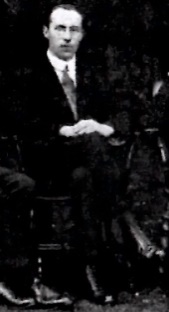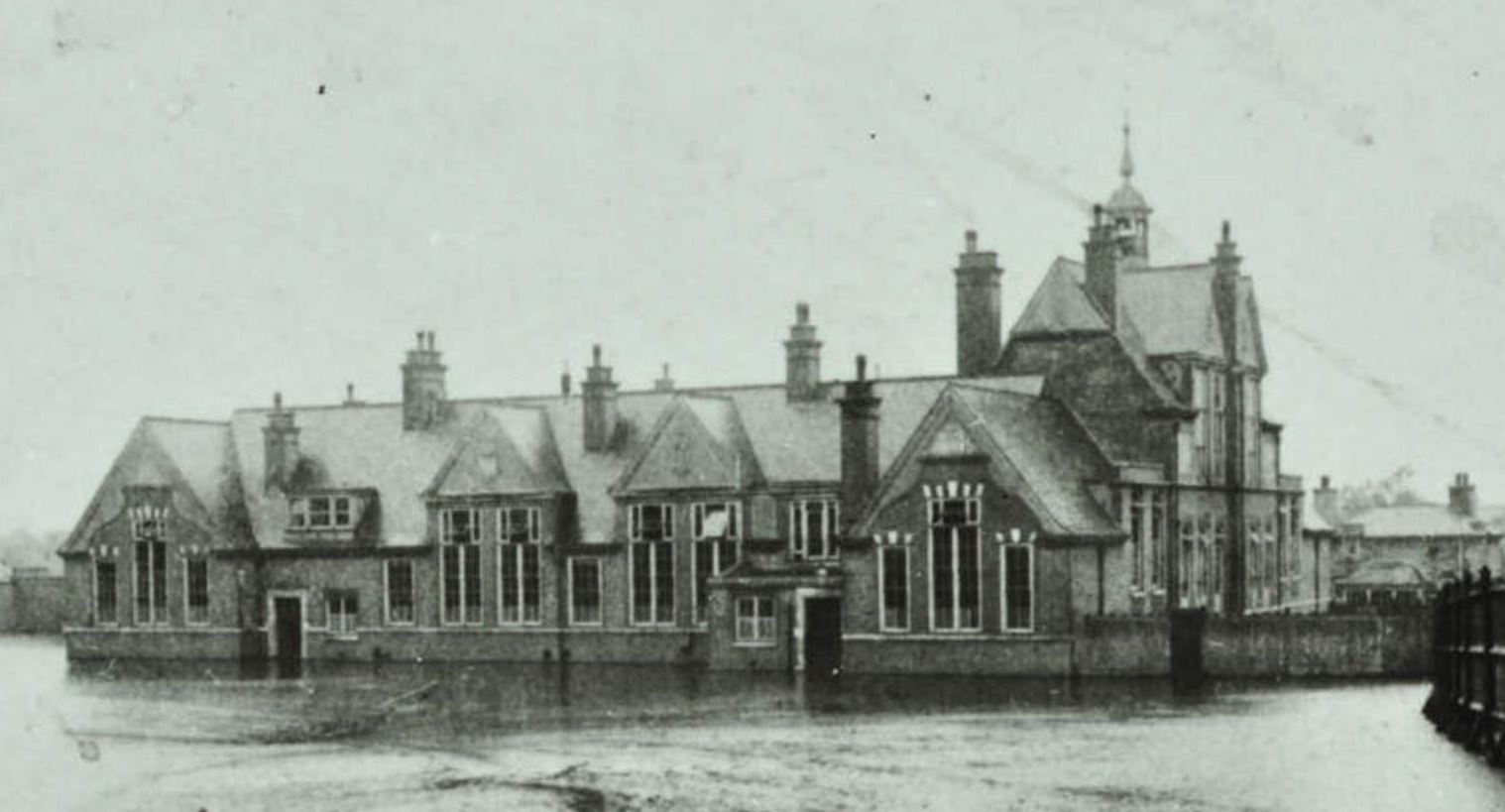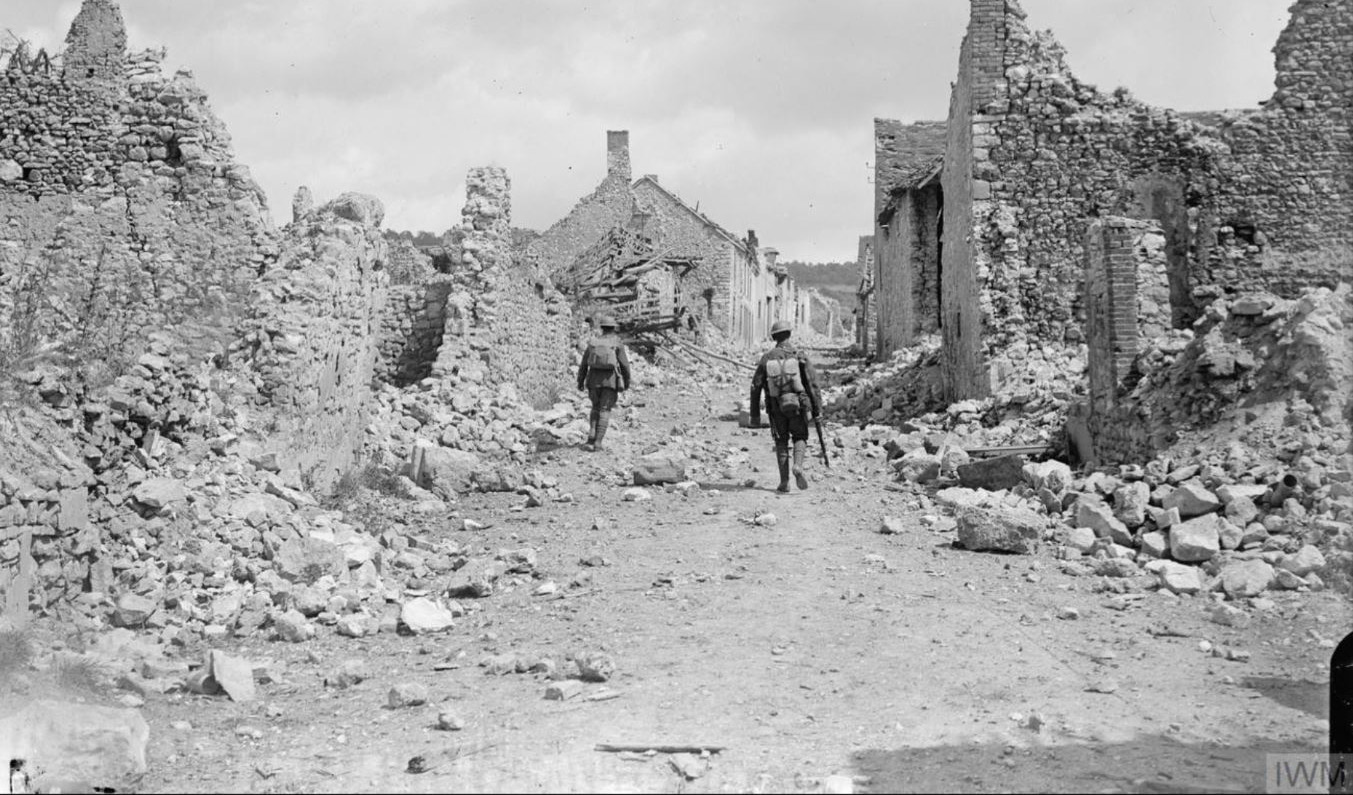Cecil Fred Wilson
27th May 1892”27th July 1918
Lieutenant Cecil Fred Wilson of the 4th (Territorial) Battalion, Hampshire Regiment died of wounds on 27th July 1918 in France.
Family and Home Life
Cecil’s paternal grandfather, John, was a Worcestershire shoemaker, born in 1826. He moved to Buckinghamshire where he met and married Mary Ann (née Mealing, born 1831) who was born and lived in High Wycombe. They had nine children, spanning the years 1852 to 1874. Frederick, Cecil’s father was the third of seven sons and their fourth child, born 1859 in Whitchurch, Buckinghamshire.
On the distaff side of his family, the surname Isaacson may at first sight suggest Jewish roots, and the collection of given-names amongst his grandfather’s siblings:Benhadad, Azuba, Thirsah, Mahala, Elisheba, Chedorlaome (known within the family as Chid), etc.,1 would appear to strengthen this appearance. However, family contact indicates that there is no evidence of Jewish ancestry.2 This is supported by a survey of others’ genealogical work on distantly-related or unrelated Isaacsons in the Cambridge fens, where no evidence of Jewish ethnicity or practice has been found.
Cecil’s mother’s forebears were non-conformists: Baptist and, later, Congregationalist, attending chapels in Lode and Swaffham Bulbeck.3 We also need to note that given-names drawn from the Old Testament were frequently, though not exclusively, used by non-conformists, however the names listed are uncommon (especially Benhadad, which is very rare in either Christian or Jewish traditions). Most males in this branch of the family are recorded as agricultural labourers.
Cecil’s mother, Eleanor, was born in 1862 at Swaffham Bulbeck. She was the fourth daughter and eighth child in a family of nine, giving Cecil an impressive total of eighteen bloodline aunts and uncles. She married Frederick in Brentford, Middlesex, in the Summer of 1889. Cecil was their first child, born three years after their marriage, on 27th May, 1892, and baptised on 10th July at St. Stephen’s Church, West Ealing. He was followed sixteen months later by sister Dorothy Eleanor. In May 1896, the birth of Harold Isaacson Wilson completed the family. All three children were born at the family home in Ealing. Frederick is variously recorded in census returns as a gardener, jobbing gardener, domestic gardener, and in 1911 as gardener (employer). The family lived in West Ealing throughout the three available censuses covering their family life, though they did move street address each time.
Cecil was educated in an Ealing primary school and went on to study at Isleworth County School.4 At the age of sixteen he passed London University Matriculation examinations.5 Dating from 1838, the breadth of London University Matriculation had an impact on the future of school curriculum:
London matriculation won a place for itself as a school-leaving examination quite independently of its function as a test for university entrance, and, including, as it did, English history, geography, chemistry, and natural history, played a great part in the modernization of the curriculum of the secondary schools.6
Ealing at the turn of the Century. Copyright unknown
By 1911, eighteen-year-old Cecil is recorded in the census return as an Assistant Teacher at a County Council school, probably at primary level.7 At this time, Dorothy, seventeen, was an apprentice in the accounts (Counting House’) of a draper’s, and Harold, 14, a stores boy at an instrument maker’s.8
In order to progress in the teaching profession, Cecil would need to undergo formal training at a training college. This would give him Certificated Teacher status and allow him, after two further years satisfactory teaching experience, to move into a schoolmaster’s roll at higher salary.
Entrance to college was by examination”the King’s Scholarship exam. A 1st or 2nd class pass in this qualified the holder to enter training college, although it didn’t guarantee it. Cecil evidently succeeded not only in the exams but in securing a place. At the turn of the Century, applicants had been far more numerous than places and less than half were successful. Many assistant teachers therefore remained as assistants throughout their career. The situation had eased somewhat by the time of Cecil’s application. Indeed, by 1914 the situation had reversed. At a meeting of ex-Winchester Training College students (Winton Club), a newspaper report carries information on the subject, voiced by Rev. E.G. Wainwright,9 Principal of the College:
With reference to the supply of teachers he instanced the difficulty now experienced by principals of Training Colleges in getting sufficient students to fill these institutions. If we were not to have a most serious shortage of teachers, he would suggest some return to a modified form of the pupil teacher system.’10
In the early Autumn of 1911 Cecil left home for two years of study and training in Winchester.
Training at Winchester Training College
1911“ 1913
The student body at the College in early 1911 had been eighty-two strong”sufficiently small to know everyone and yet large enough to support many social and sporting activities. This combination, cemented by a common background and goal in teaching, forged strong ties between the students. A corollary of this enduring camaraderie was, as mentioned above, The Winton Club”an association of alumni that fostered on-going friendship and nurtured the society of ex-students.
The majority of students also shared a common military experience, enlisting during their first days in the Army unit attached to the College: B Company of the 4th Territorial Battalion of the Hampshire Regiment. Parades, drill, summer camps and rifle practice were part of normal student experience. Cecil was enlisted in his first week at College, on the 4th September.
Some snapshots of College life were recorded in The Wintonian, a student-produced magazine. Cecil was appointed Editor of the magazine. This is perhaps unfortunate for us, as modesty would dictate that he would avoid publishing articles about himself. An edition published after he left the college reports, On Friday March 13th, the 11-13 men resident in and around London held their first reunion Those present were Burt, Dobson, Eason, Hotten, Moore A.R., Wootton, and Wilson.’ Sadly, all of these men would to make the ultimate sacrifice in the Great War, as would twelve others with whom he had rubbed shoulders during his studies.
To the Western Front
On 30th August 1915, Cecil responded to the call to arms and enlisted in the oldest regiment in the British Army: the Honourable Artillery Company.13 He was assigned to No.2 Company, 3rd Battalion.14 This acted as a Reserve Battalion, with men passing through it to other units. Cecil entered the HAC at the rank of Lance Corporal in the Battalion. His Medal Index Card records that he did not see overseas service in the HAC. He was sent for Officers’ training at Officers’ Training Corps the following Summer. The course usually lasted around four months. On December 29th, Cecil’s name appears in The London Gazette:
Territorial Force. Infantry. The undermentioned cadets to be 2nd Lts. (on prob.). 19th Dec. 1916: Hampshire Regt.”Cecil Fred Wilson.’
We know from his Army medical records that he spent time on Home Service from 19th January, 1917 as he was unfit for General Service, diagnosed with hammer toes. His left and right second toes were amputated at Mount Dore Military Hospital, Bournemouth. Throughout recovery he was classified for light duty and home service and monthly medical assessments were made. His return to fitness for General Service was reported on 2nd October when he was ordered to report to 4th Battalion, Hampshire Regiment.
The next we hear of him is in December of 1917, when he landed in Egypt. He was with the 2/4th Hampshires who were engaged with German-backed Ottoman forces.
The Battalion had been part of the 233rd Brigade in 75th Division, fighting north through Palestine. The offensive had been successful, driving the enemy from position after position until, on 11th December, British troops entered Jerusalem. It is likely that Cecil would have moved from Egypt to Palestine by one of the supply shuttle ships running between Alexandria and Jaffa, arriving there to be part of the defence of Jerusalem against the counter-attacks of the Ottomans.
The spring of 1918 was a time of great change for the Egyptian Expeditionary Force. It had been decided to Indianise the Divisions serving in Palestine by substituting Indian Army units for British ones. This was principally to shorten supply lines, which were expensive and complex: men and goods coming from Britain into Egypt before moving up to Palestine. Also driving this change was the need on the Western Front. The British army had suffered heavy losses in the German offensive of March 1918. Reinforcements were urgently needed, and many of the units released by Indianisation in Palestine moved to the Western Front.
On 26th May 1918, the day before Cecil’s twenty-sixth birthday, the battalion embarked at Alexandria, sailing to Marseilles, where it arrived on 1st June. By June 15th the men were moved into support positions behind the front line near Gommecourt, on the northwest edge of the Somme battlefield. On this day, Cecil was promoted from 2nd Lieutenant to Lieutenant. The Battalion War diary makes no mention of enemy activity but casualties through the month of June were light: 6 wounded. Throughout these early days on the Western Front, Commissioned Officers were systematically given home leave,15 though no mention is made of Cecil in this respect.
July commenced with the Battalion behind lines in training. At 3am on the 15th, they entrained at nearby Mondicourt, destination unknown’, arriving next day at Sommesous, 125 miles to the southeast. Motor transport then took them to billets. On the 19th they marched to Germaine. The Hampshires were now entering the Marne combat area. There they would be engaged in the Second Battle of the Marne which had begun four days previously with a massive German attack.
By the 19th, the day of the 2/4th Hants arrival, the Germans had failed to make the gains envisaged and were on the retreat under strong counter-attack. At 8am on 20th, the Battalion being in the centre of 3 Battalions, part of 186th Brigade, began an attack. Leaving their position at Cortagnon Far, they immediately came under heavy artillery fire but the Battalion advanced quite steadily and coolly’ towards their objective: the village of Marfaux. Things did not continue so well:
The attack was continued. B and D Companies leading with A Company in support, but in spite of the bravery of all ranks it was impossible to reach Marfaux as the enemy held the village and all the high ground overlooking the village with impregnable machine guns. Small bodies managed to reach the outskirts of Marfaux but this position was untenable and the Battalion dug in about 500 yards east of the village. The consolidation was carried out successfully although the Battalion was subjected to heavy artillery and machine gun fire the whole day’
Ruins of Marfaux captured by the 62nd Division, 21-23 July 1918. © IWM (Q 6858)
The following day and on into the 22nd, the situation was unchanged. The Battalion remained pinned down in their positions by artillery and machine-gun fire. Then…
During the night orders received for C Company to attack Marfaux in conjunction with N.Z. Cyclist Corps”forming up place astride Pourcy-Marfaux Road.’
23rd. ZERO hour was 8am. A very good barrage was put down, full advantage of which was taken and the village was soon in our hands. 8 machine guns and 130 prisoners including 2 officers Captain W.H. Ledgard received a nasty wound early on but in a very gallant manner carried on. CASUALTIES: Killed 6 Other Ranks. Died of Wounds: Lieutenant C.F. Wilson. Wounded Captain W.H. Ledgard and 20 Other Ranks.’
The casualty list appears at the bottom of that day’s diary sheet and must be a later gloss. Cecil died of his wounds at No. 48 Casualty Clearing Station, south of Epernay, on 27th July, 1918.16
He lies buried in the Terlingthun British Cemetery, Wimille, Pas de Calais, France.17
His name is also listed in the London University War List.18
Researcher and Author: John Vickers
Footnotes
[1] For this information we are indebted to Gillian Figures, Cecil’s third cousin twice removed
[2] Ibid
[3] This reference to religious affiliation is not offered as a comment on the foregoing brief discussion on Jewish roots: ethnicity is not always consonant with religious belief. It is possible to be Jewish with non-Jewish beliefs, or non-Jewish with Jewish beliefs.
[4] De Ruvigny’s Roll of Honour 1914-1919
[5] Ibid.
[6] http://www.british-history.ac.uk/vch/middx/vol1/pp315-344
[7] After training, he took up a position at a primary school.
[8] Possibly The Stanley Works (Stanley Mathematical Instruments) Norwood. It manufactured a variety of instruments for civil, military, and mining engineers, prospectors and explorers, architects, meteorologists and artists, including various technical drawing tools.
[9] Rev. Ernest Wainwright, Honorary Canon of Winchester Cathedral and College Principal 1912-1933.
[10] Portsmouth Evening News – Monday 09 February 1914 reporting the Fifth Annual Dinner of the Portsmouth Winton
[11] Sources: De Ruvigny’s Roll of Honour 1914-1919, National Union of Teachers War Record 1914“1919, and College records.
[12] De Ruvigny
[13] Established by Henry VIII in 1537 when he granted a charter to the Guild of Artillery of Longbows, Crossbows and Handguns for the better increase of the defence of this our realm’ and the maintenance of the science of artillery’. (Source: https://www.hac.org.uk/home/about-the-hac/history/ )
[14] Listed as 3rd Battalion in the College’s special War Supplement. Published June 1916.
[15] From the Ranks mentioned in the Diary data, 2nd Lieutenants, Lieutenants and Captains were given 14 days, and a Lieutenant Colonel 30 days.
[16] De Ruvigny
[17] Commonwealth War Graves Commission. A different burial place is recorded in De Ruvigny: British Cemetery, Epernay’. This location is unknown. Some war graves from July 1918 are in the Marfaux British Cemetery which is 10 miles from Epernay, but Cecil’s is not among them.
[18] He is not listed as War Dead as the list was published in May 1918
Sources
Ancestry (2018). Home page. [online] Available at: www.ancestry.co.uk [Accessed 2018].
British History Online (1969). The University of London: The University. [online] Available at: http://www.british-history.ac.uk/vch/middx/vol1/pp315-344 [Accessed 2018].
Collage (2018). The London Picture Archive: Rosendale School. [online] Available at: https://collage.cityoflondon.gov.uk/view-item?key=SXsiUCI6eyJ2YWx1ZSI6InJvc2VuZGFsZSBzY2hvb2wiLCJvcGVyYXRvciI6MSwiZnV6enlQcmVmaXhMZW5ndGgiOjMsImZ1enp5TWluU2ltaWxhcml0eSI6MC43NSwibWF4U3VnZ2VzdGlvbnMiOjMsImFsd2F5c1N1Z2dlc3QiOm51bGx9fQ&pg=21&WINID=1529504744604#6XRzozStF50AAAFkHZZFFg/181404 [Accessed 2018].
Commonwealth War Graves Commission, (2018). Home page. [online] Available at www.cwgc.org/ [Accessed 2018].
Honourable Artillery Company (2018). Home page. [online] Available at: https://www.hac.org.uk/home/about-the-hac/history/ [Accessed 2018].
Imperial War Museum (2018). Image IWM Q 6858. [online] Available at https://www.iwm.org.uk/collections/item/object/205238738 [Accessed 2018].
National Union of Teachers. (1920). War Record 1914“1919. A Short Account of Duty and Work Accomplished During the War. London: NUT.
Rose, M. (1981). A history of King Alfred’s College, Winchester 1840-1980. London: Phillimore.
University of London. (1918). War List. [PDF] London: London University Press Ltd. Available at: http://archives.ulrls.lon.ac.uk/resources/WARLISToptimised-OCR.pdf [Accessed 2018].
Vickers, J. University of Winchester Chapel Memorial Rail image.
| University of Winchester Archive “ Hampshire Record Office | ||
| Reference code | Record | |
| 47M91W/ | P2/4 | The Wintonian 1899-1900 |
| 47M91W/ | P2/5 | The Wintonian 1901-1902 |
| 47M91W/ | P2/6 | The Wintonian 1903-1904 |
| 47M91W/ | P2/7 | The Wintonian 1904-1906 |
| 47M91W/ | P2/8 | The Wintonian 1905-1907 |
| 47M91W/ | P2/10 | The Wintonian 1908-1910 |
| 47M91W/ | P2/11 | The Wintonian 1910-1914 |
| 47M91W/ | P2/12 | The Wintonian 1920-1925 |
| 47M91W/ | D1/2 | The Student Register |
| 47M91W/ | S5//5/10 | Photograph of 5 alumni in Mesopotamia |
| 47M91W/ | Q3/6 | A Khaki Diary |
| 47M91W/ | B1/2 | Reports of Training College 1913-1914 |
| 47M91W/ | Q1/5 | Report and Balance Sheets 1904- 1949 |
| 47M91W/ | R2/5 | History of the Volunteers Company 1910 |
| 47M91W/ | L1/2 | College Rules 1920 |
| Hampshire Record Office archive | ||
| 71M88W/6 | List of Prisoners at Kut | |
| 55M81W/PJ1 | Managers’ Minute Book 1876-1903 | |
| All material referenced as 47M91W/ is the copyright of The University of Winchester. Permission to reproduce photographs and other material for this narrative has been agreed by the University and Hampshire Record Office. | ||







